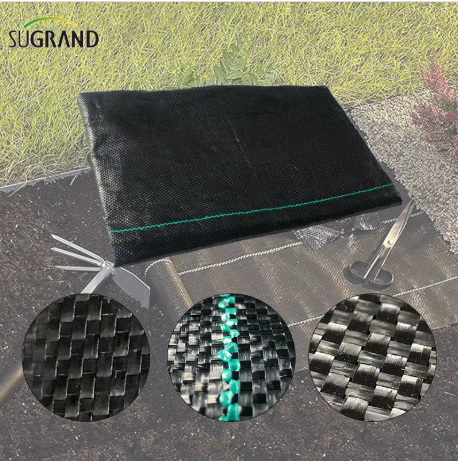Hefei Grand Nets Co., Ltd.
Call Us: +86 15605607108
E-mail: sugrand@grandnets.com
WhatsApp:+86 15605607108
- All
- Product Name
- Product Keyword
- Product Model
- Product Summary
- Product Description
- Multi Field Search
Views: 0 Author: Site Editor Publish Time: 2025-07-21 Origin: Site
Woven ground cover is commonly used in landscaping, gardening, and agriculture for its ability to suppress weeds, control erosion, and retain moisture. However, understanding how long woven ground cover lasts outdoors is essential for long-term planning. The lifespan of woven ground cover depends on several factors, such as material quality, environmental conditions, and maintenance practices.
Woven ground cover is made from synthetic or natural fibers woven together to create a durable fabric. Common materials include polypropylene, polyethylene, and natural fibers like coir or jute. These covers prevent weed growth, reduce soil erosion, and retain moisture, making them a popular choice for garden beds, pathways, and larger agricultural areas.
The primary reason for using woven ground cover is weed suppression. By blocking sunlight, it prevents weeds from germinating. It also protects against soil erosion, especially in areas with slopes or heavy rainfall, and helps retain moisture in dry conditions.

UV Resistance and Sunlight Exposure: UV rays break down fibers in woven ground covers, causing fading and brittleness. UV-resistant coatings or additives extend the fabric's life.
Climate Conditions: Extreme temperatures, humidity, and rainfall can speed up degradation, particularly in areas with fluctuating weather.
Material Thickness and Quality: Thicker, high-quality materials tend to last longer. Synthetic fabrics like polypropylene last longer than natural fibers like coir or jute.
Synthetic Fabrics: Polypropylene and polyethylene covers last around 5-10 years when treated with UV inhibitors.
Natural Fiber Covers: Coir, jute, and hemp covers are more biodegradable and last about 1-3 years.
UV rays degrade the fibers in woven ground covers, causing fading and weakening. UV-resistant additives improve durability and extend the lifespan, especially in sunny areas.
Extreme Temperatures: High or low temperatures can cause the fabric to become brittle.
Humidity: Moist conditions can promote mold growth on natural fibers, accelerating degradation.
Rain and Wind: Heavy rainfall or wind can cause physical damage, tearing the fabric or loosening it from the soil.
Thicker, high-quality fabrics provide better protection against the elements. Stronger, synthetic fibers offer greater resistance to UV degradation and wear.
Spacing and Overlap: Ensure the fabric is laid flat with proper overlap to prevent weed growth.
Securing the Fabric: Use pins or staples to keep the fabric in place and protect it from wind or foot traffic.
Use UV Inhibitors: Choose woven covers treated with UV inhibitors for better longevity.
Add Mulch: Covering the fabric with mulch or another protective layer helps shield it from direct sun and reduces UV exposure.
Inspect for Damage: Periodically check for tears or holes and patch them as needed.
Weed Management: Keep weeds in check, especially in areas where the fabric has worn out.
Color Fading: UV exposure causes the material to lose color.
Brittleness: As the material degrades, it becomes fragile and prone to tearing.
Visible Holes or Tears: Damaged areas reduce the cover's effectiveness at controlling weeds and preventing soil erosion.
Woven ground cover differs from other materials like mulch, gravel, and plastic sheeting in several ways:
Woven Fabric vs. Mulch: Mulch is biodegradable and organic, while woven fabric lasts longer and is more durable, especially for weed control.
Woven Fabric vs. Plastic Sheeting: Plastic sheeting may crack and become brittle over time, while woven ground cover is more breathable and allows water to pass through.
Woven ground cover made from synthetic materials like polypropylene is better for long-term use, offering superior UV resistance and durability compared to alternatives like mulch or plastic sheeting.
Woven ground cover provides significant benefits for outdoor use, including weed suppression, erosion control, and moisture retention. Its lifespan depends on factors like UV exposure, climate, and material quality. By choosing high-quality materials and following proper installation and maintenance practices, you can maximize the longevity and effectiveness of your woven ground cover.
Q: How Long Does Woven Ground Cover Last in the Sun?
A: Woven ground cover with UV inhibitors lasts 5-10 years in full sunlight.
Q: Can Woven Ground Cover Be Repaired if It Gets Damaged?
A: Minor damage, like small holes, can be repaired, but significant damage may require replacement.
Q: What is the Best Woven Ground Cover for Harsh Weather Conditions?
A: Synthetic woven ground covers treated with UV stabilizers and thicker materials are ideal for harsh weather.